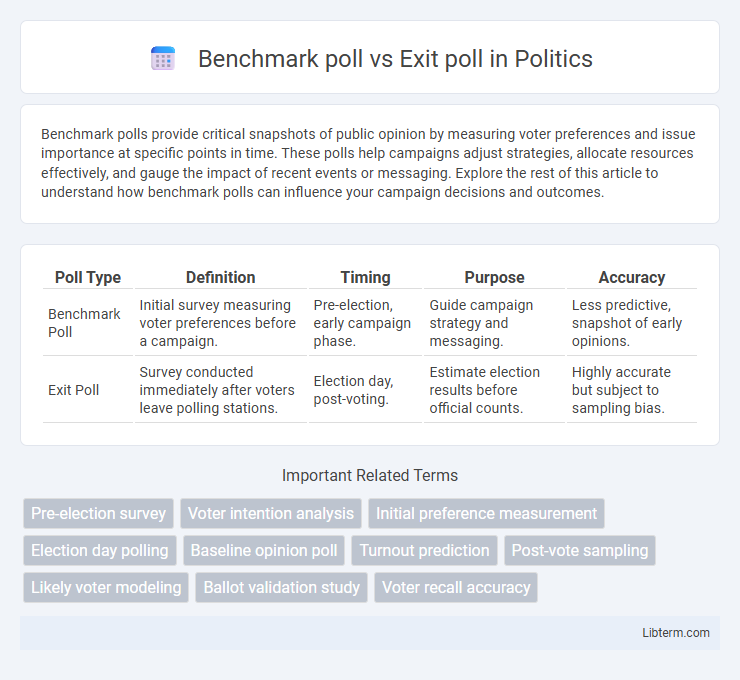Benchmark polls provide critical snapshots of public opinion by measuring voter preferences and issue importance at specific points in time. These polls help campaigns adjust strategies, allocate resources effectively, and gauge the impact of recent events or messaging. Explore the rest of this article to understand how benchmark polls can influence your campaign decisions and outcomes.
Table of Comparison
| Poll Type | Definition | Timing | Purpose | Accuracy |
|---|---|---|---|---|
| Benchmark Poll | Initial survey measuring voter preferences before a campaign. | Pre-election, early campaign phase. | Guide campaign strategy and messaging. | Less predictive, snapshot of early opinions. |
| Exit Poll | Survey conducted immediately after voters leave polling stations. | Election day, post-voting. | Estimate election results before official counts. | Highly accurate but subject to sampling bias. |
Introduction to Benchmark Polls and Exit Polls
Benchmark polls measure public opinion before a political campaign begins, establishing a baseline to track shifts in voter sentiment over time. Exit polls collect data immediately after voters leave polling stations, providing real-time insights into election day behavior and candidate performance. Both methods offer valuable but distinct perspectives for analyzing electoral dynamics and forecasting outcomes.
Defining Benchmark Polls
Benchmark polls serve as initial measurements of public opinion on candidates or issues before a campaign gains momentum, providing baseline data for strategists to shape messaging and resource allocation. Unlike exit polls that collect data from voters immediately after they cast ballots, benchmark polls survey a representative sample of the electorate well ahead of election day. These polls analyze voter preferences, demographic attitudes, and awareness levels, enabling campaigns to identify strengths, weaknesses, and undecided voters early in the election cycle.
What Are Exit Polls?
Exit polls are surveys conducted immediately after voters leave polling stations, designed to predict election outcomes by gathering data on voter choices and demographics. These polls provide real-time insights during election days, contrasting with benchmark polls that measure voter intentions well before elections. Exit polls are critical for media and analysts to assess election trends and identify potential shifts in voter behavior.
Key Differences Between Benchmark and Exit Polls
Benchmark polls measure voter preferences early in an election cycle to assess candidate strengths and campaign strategies, while exit polls collect data from voters immediately after they cast their ballots to predict election outcomes and analyze voter behavior. Benchmark polls typically gauge overall sentiment and issue priorities before campaigning intensifies, whereas exit polls provide real-time insights into actual voter decisions and demographic breakdowns. The timing and purpose distinctly differentiate benchmark polls as preliminary indicators from exit polls as immediate post-voting analyses.
The Purpose of Benchmark Polls in Campaigns
Benchmark polls serve as an initial measurement of voter attitudes and candidate support early in a political campaign, providing campaigns with crucial data to shape strategy, messaging, and resource allocation. Unlike exit polls, which capture voter preferences immediately after casting ballots on election day, benchmark polls identify baseline opinions and track shifts over time. These early insights allow campaign teams to tailor outreach efforts effectively, targeting demographic groups and geographic areas where support needs to be built or improved.
How Exit Polls Influence Election Night Reporting
Exit polls provide immediate voter behavior insights after individuals leave polling stations, offering real-time data that shapes election night reporting and media projections. Unlike benchmark polls, which measure overall voter preferences weeks before the election, exit polls capture dynamic shifts and final decisions influencing media narratives and public perception. Their accuracy directly impacts the speed and confidence of election result announcements, often setting the tone for real-time electoral analysis.
Methodologies: Benchmark vs. Exit Polls
Benchmark polls utilize randomized sampling of registered voters before an election to gauge baseline public opinion, often incorporating demographic weighting to reflect the electorate accurately. Exit polls, conducted immediately after voters leave polling stations, employ stratified sampling techniques targeting specific precincts to capture real-time voting behavior and validate election outcomes. Both methodologies differ significantly in timing, sampling strategies, and purpose, with benchmark polls aiming for predictive insights and exit polls focusing on post-vote analysis.
Strengths and Limitations of Each Poll Type
Benchmark polls provide valuable baseline data on voter preferences before campaigns begin, offering insights into initial public opinion trends, but they can be limited by low voter engagement and changing sentiments over time. Exit polls capture voter behavior immediately after voting, delivering near real-time data on election outcomes and demographic breakdowns, though they may suffer from sampling bias and nonresponse errors. Both poll types contribute critical electoral information, yet their accuracy depends on timing, methodology, and sample representativeness.
Real-world Examples of Benchmark and Exit Poll Usage
Benchmark polls provide baseline data before elections, exemplified by the 2020 U.S. presidential race where surveys gauged initial voter intentions, shaping campaign strategies. Exit polls, conducted immediately after voting, offered accurate predictions during the 2016 Brexit referendum, revealing voter demographics and turnout patterns in real-time. Both poll types inform political analysts by comparing pre-election expectations with actual voter behavior, enhancing electoral forecasts.
Conclusion: Choosing the Right Poll for Strategic Analysis
Benchmark polls provide a snapshot of voter preferences early in an election cycle, making them essential for shaping campaign strategies and resource allocation. Exit polls capture voter behavior immediately after voting, offering accurate insights into election outcomes and demographic trends. Selecting the right poll depends on the campaign phase: benchmark polls guide long-term planning, while exit polls deliver critical data for real-time analysis and post-election evaluations.
Benchmark poll Infographic

 libterm.com
libterm.com